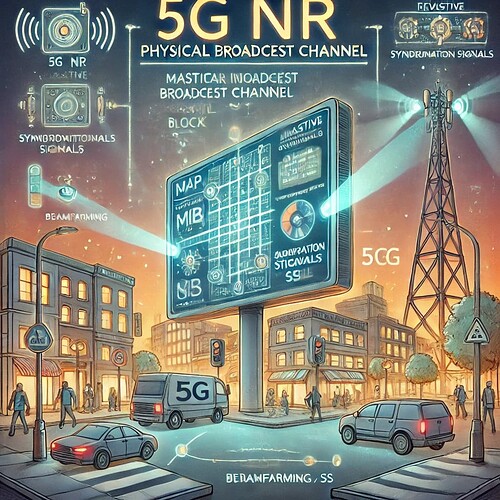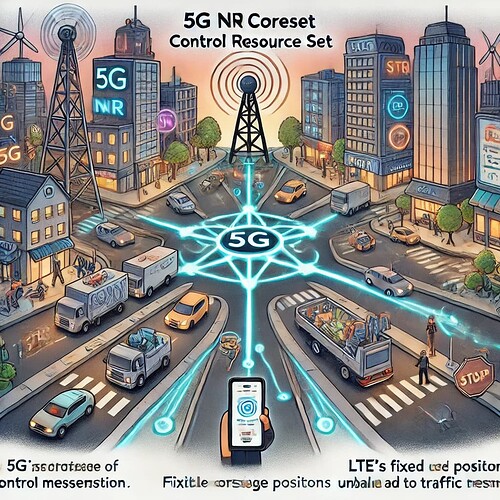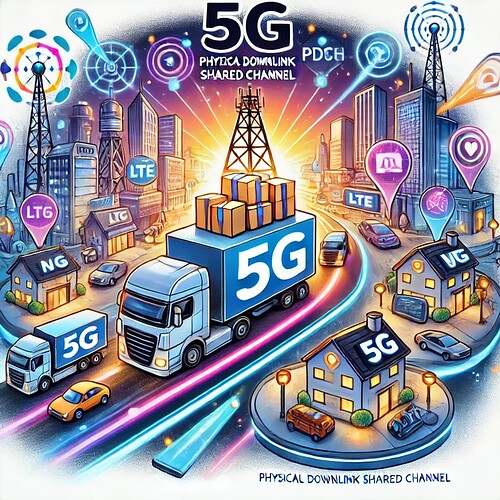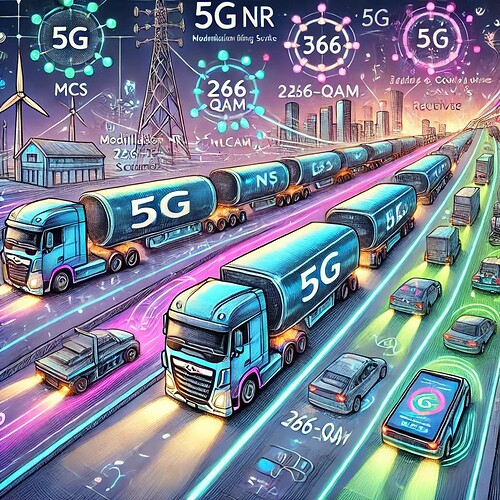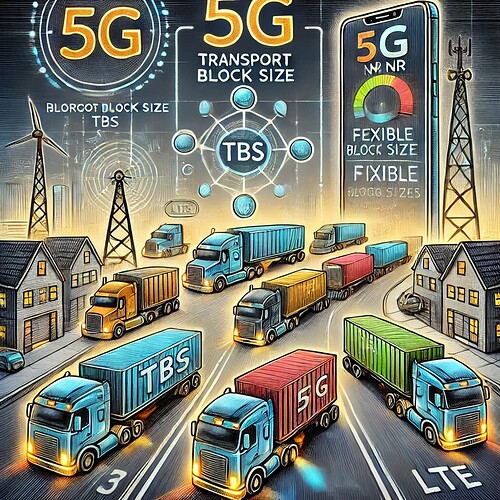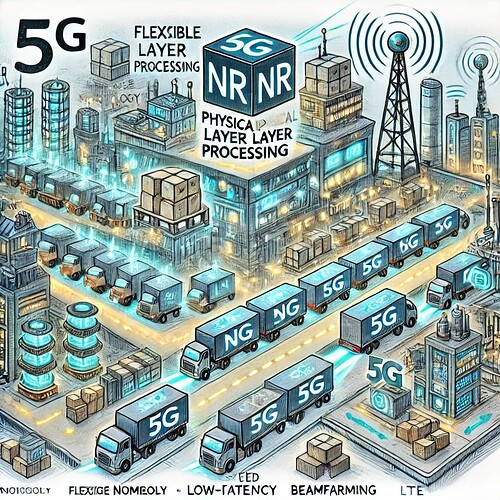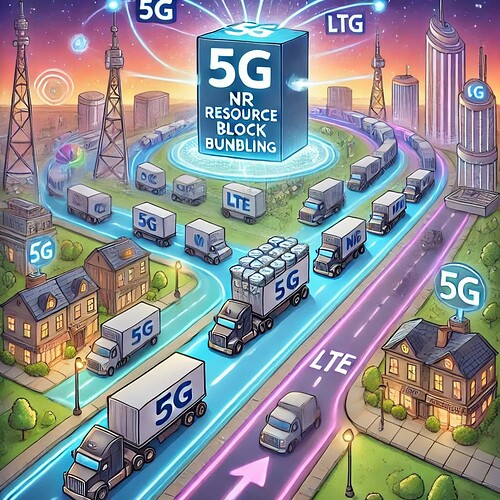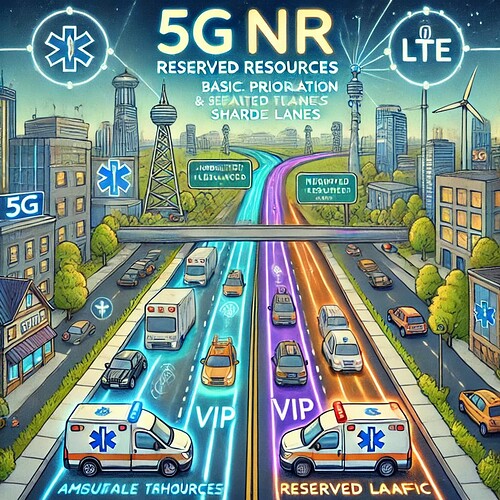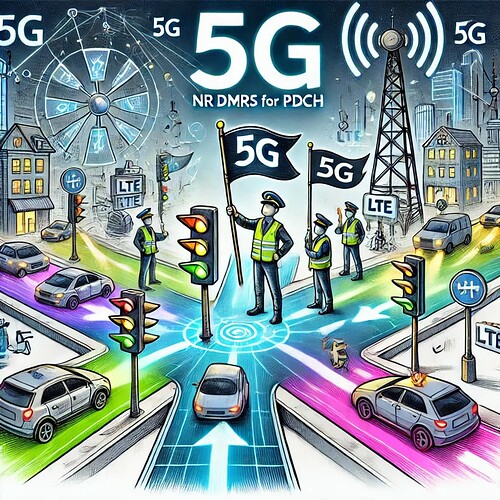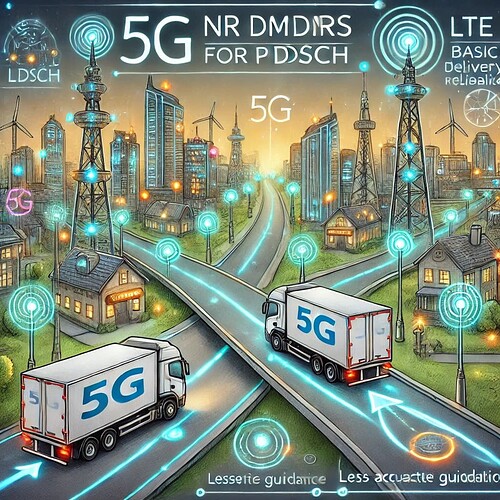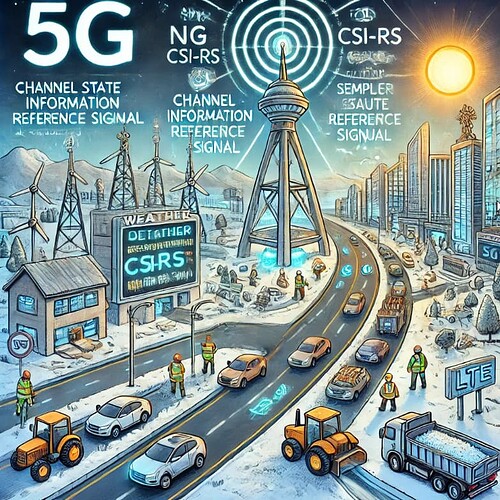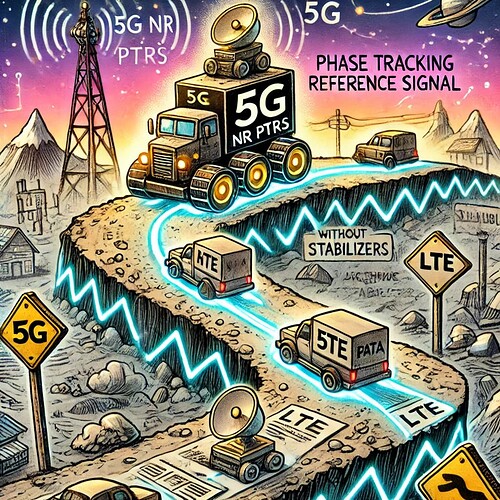This topic presents in a very simplified way all the main concepts that should be understood by those who know 5G NR.
5G NR Downlink Signals and Channels
5G NR downlink signals and channels enable efficient communication by organizing and transmitting various types of data from the network to devices. Downlink Channel Mappings ensure that user data, control instructions, and system information are categorized and routed effectively. Key components like Synchronization Signals (SS) and the Physical Broadcast Channel (PBCH) help devices detect the network and establish a connection using combined structures called SS/PBCH Blocks and Bursts. The Physical Downlink Control Channel (PDCCH) sends essential instructions about resource allocation and scheduling, managed within a configurable area called the CORESET (Control Resource Set). Search Space Sets (SSS) help devices locate control signals, including critical information like the System Information Block 1 (SIB1). Data is delivered through the Physical Downlink Shared Channel (PDSCH), optimized with advanced features like Modulation and Coding Scheme (MCS) and dynamic Transport Block Size (TBS) calculations. Supporting these functions are various Reference Signals (RS), such as DMRS (Demodulation Reference Signals) for accurate decoding, and CSI-RS (Channel State Information Reference Signals) for channel quality assessment. Additionally, features like Pre-emption, Reserved Resources, and Repetition ensure reliability and prioritization for critical communications, making 5G far more flexible, efficient, and capable than LTE. [In a Nutshell: 5G organizes, prioritizes, and delivers data more flexibly and efficiently than LTE, ensuring reliability and scalability.]
![]() The city of 5G is a smarter, faster upgrade from the city of LTE, with better organization and advanced traffic systems. In 5G, Synchronization Signals (SS) act as welcome lights, helping devices find their way, while the PBCH (Physical Broadcast Channel) is like a digital map showing city rules, now combined in SS/PBCH Blocks and Bursts for efficiency. PDCCH (Physical Downlink Control Channel) is like traffic officers directing trucks (data) to their destinations, working flexibly in areas called CORESET (Control Resource Set). Devices find instructions in Search Space Sets (SSS), including special help desks like SIB1 Search Space for new visitors. Data is delivered by bigger, faster trucks on the PDSCH (Physical Downlink Shared Channel), optimized by smarter cargo systems like MCS and TBS. To keep things on track, 5G uses advanced markers like DMRS and updates like CSI-RS, while features like Pre-emption and Reserved Resources ensure emergency lanes and VIP routes for critical services. It’s a futuristic city built to handle more traffic and complexity than LTE ever could. [In a Nutshell: 5G is like a futuristic city with smarter traffic systems, ensuring faster and more reliable communication than LTE.]
The city of 5G is a smarter, faster upgrade from the city of LTE, with better organization and advanced traffic systems. In 5G, Synchronization Signals (SS) act as welcome lights, helping devices find their way, while the PBCH (Physical Broadcast Channel) is like a digital map showing city rules, now combined in SS/PBCH Blocks and Bursts for efficiency. PDCCH (Physical Downlink Control Channel) is like traffic officers directing trucks (data) to their destinations, working flexibly in areas called CORESET (Control Resource Set). Devices find instructions in Search Space Sets (SSS), including special help desks like SIB1 Search Space for new visitors. Data is delivered by bigger, faster trucks on the PDSCH (Physical Downlink Shared Channel), optimized by smarter cargo systems like MCS and TBS. To keep things on track, 5G uses advanced markers like DMRS and updates like CSI-RS, while features like Pre-emption and Reserved Resources ensure emergency lanes and VIP routes for critical services. It’s a futuristic city built to handle more traffic and complexity than LTE ever could. [In a Nutshell: 5G is like a futuristic city with smarter traffic systems, ensuring faster and more reliable communication than LTE.]
Skip to: Roadmap to 5G NR
- Downlink Channel Mappings
- SS (Synchronisation Signals)
- PBCH (Physical Broadcast Channel)
- SS/PBCH Blocks and Bursts
- PDCCH (Physical Downlink Control Channel)
- CORESET (Control Resource Set)
- SSS (Search Space Sets)
- Search Space Set (SIB1)
- DCI (Downlink Control Information)
- DCI Formats (0_0 to 2_3)
- PDSCH (Physical Downlink Shared Channel)
- MCS (Modulation and Coding Scheme)
- TBS (Transport Block Size)
- Physical Layer Processing
- Resource Allocations
- Resource Block Bundling
- Pre-emption
- Reserved Resources
- Repetition
- RS (Reference Signals)
- DMRS (Demodulation Reference Signal) for PBCH
- DMRS (Demodulation Reference Signal) for PDCCH
- DMRS (Demodulation Reference Signal) for PDSCH
- CSI-RS (Channel State Information Reference Signal)
- TRS (Tracking Reference Signal)
- PTRS (Phase Tracking Reference Signal)
Downlink Channel Mappings
In 5G NR, downlink channel mappings organize how various types of data - such as user data, control signals, and system information - are transmitted from the network to devices. These mappings are divided into three levels: logical channels (defining the type of information), transport channels (how the data is carried), and physical channels (the actual radio transmission). Compared to LTE, 5G offers more flexible and dynamic mappings, enabling it to efficiently handle diverse scenarios like higher data speeds, more simultaneous users, and varied application requirements. This flexibility ensures optimal performance across a wide range of use cases. While LTE had a fixed mapping structure, 5G NR allows for dynamic allocation of resources, improving efficiency and performance. [In a Nutshell: 5G’s dynamic mapping ensures faster, more efficient handling of diverse data compared to LTE’s fixed structure.]
![]() Imagine a city where roads guide cars, buses, and bikes to their destinations. In 5G’s city, these roads are smarter and adapt to handle more traffic than LTE’s city. “Downlink Channel Mappings” are like those roads, organizing how data (cars) is sent to devices (homes or offices) in the fastest and most efficient way. [In a Nutshell: 5G’s smarter roads adapt to handle more traffic efficiently than LTE.]
Imagine a city where roads guide cars, buses, and bikes to their destinations. In 5G’s city, these roads are smarter and adapt to handle more traffic than LTE’s city. “Downlink Channel Mappings” are like those roads, organizing how data (cars) is sent to devices (homes or offices) in the fastest and most efficient way. [In a Nutshell: 5G’s smarter roads adapt to handle more traffic efficiently than LTE.]
- Search Forum
 5G NR Downlink Channel Mappings
5G NR Downlink Channel Mappings 
SS (Synchronisation Signals)
Synchronization Signals (SS) are crucial for helping devices find (detect) and align (synchronize) with the network. These include the Primary Synchronization Signal (PSS), which helps identify the cell, and the Secondary Synchronization Signal (SSS), which provides timing and frame synchronization. While LTE also used synchronization signals, 5G significantly enhances their flexibility by allowing multiple configurations, making it easier to operate efficiently in challenging environments such as dense urban areas or locations with overlapping signals. In 5G NR, SS are part of the SS/PBCH blocks, a new concept that enhances synchronization performance. [In a Nutshell: SS helps devices detect and synchronize with the network more flexibly and efficiently in 5G than in LTE.]
![]() In LTE’s city, streetlights blink in a fixed pattern to tell drivers where they are. In 5G, Synchronization Signals (SS) are like smarter streetlights that adjust based on traffic, helping devices find and sync with the network more easily. [In a Nutshell: 5G’s smarter streetlights help devices find and sync with the network better than LTE.]
In LTE’s city, streetlights blink in a fixed pattern to tell drivers where they are. In 5G, Synchronization Signals (SS) are like smarter streetlights that adjust based on traffic, helping devices find and sync with the network more easily. [In a Nutshell: 5G’s smarter streetlights help devices find and sync with the network better than LTE.]
- Search Forum
 5G NR SS (Synchronisation Signals)
5G NR SS (Synchronisation Signals) 
PBCH (Physical Broadcast Channel)
The Physical Broadcast Channel (PBCH) is responsible for delivering critical system information, including the Master Information Block (MIB), which provides essential details that devices need to connect to the network, such as basic network configuration and timing. While LTE also had PBCH, 5G integrates it with Synchronization Signals (SS) into a single structure - forming SS/PBCH blocks - improving efficiency and enabling advanced features like beamforming, which enhances coverage and performance in challenging environments. [In a Nutshell: PBCH delivers critical connection information, integrated with SS in 5G for better efficiency and coverage than LTE.]
![]() The PBCH is like a big billboard at the city entrance showing key (important) information to everyone - like the city’s map or speed limits. LTE had a billboard too, but in 5G, it’s digital, combined with the streetlights, and much easier to read. [In a Nutshell: 5G’s digital billboard combines key information with streetlights for easier connection setup than LTE.]
The PBCH is like a big billboard at the city entrance showing key (important) information to everyone - like the city’s map or speed limits. LTE had a billboard too, but in 5G, it’s digital, combined with the streetlights, and much easier to read. [In a Nutshell: 5G’s digital billboard combines key information with streetlights for easier connection setup than LTE.]
- Search Forum
 5G NR PBCH (Physical Broadcast Channel)
5G NR PBCH (Physical Broadcast Channel) 
SS/PBCH Blocks and Bursts
SS/PBCH Blocks and Bursts are a new feature in 5G that combines Synchronization Signals (SS) and the Physical Broadcast Channel (PBCH) into a single unit. These blocks are transmitted in short intervals called bursts, where multiple beams are used to cover different areas or directions. This design enhances the network’s ability to provide accurate and efficient coverage, especially in dense or complex environments. LTE did not have this integrated structure or support for beam-based transmission, making SS/PBCH Blocks and Bursts a significant advancement in 5G, improving initial access and beamforming capabilities. [In a Nutshell: SS/PBCH Blocks and Bursts combine signals and beams in 5G to improve coverage and initial access, unlike LTE.]
![]() These blocks are like clusters of billboards and streetlights in a neighborhood, lighting up all at once (a burst). 5G’s bursts use directional lights (beams) that guide traffic efficiently, a big improvement over LTE’s fixed lights. [In a Nutshell: 5G’s directional bursts guide traffic better than LTE’s static lights.]
These blocks are like clusters of billboards and streetlights in a neighborhood, lighting up all at once (a burst). 5G’s bursts use directional lights (beams) that guide traffic efficiently, a big improvement over LTE’s fixed lights. [In a Nutshell: 5G’s directional bursts guide traffic better than LTE’s static lights.]
- Search Forum
 5G NR SS/PBCH Blocks and Bursts
5G NR SS/PBCH Blocks and Bursts 
PDCCH (Physical Downlink Control Channel)
The Physical Downlink Control Channel (PDCCH) is responsible for delivering important control instructions to devices, such as when and how they should receive data or send responses. While LTE also used the PDCCH, 5G enhances its flexibility by enabling the network to dynamically determine the PDCCH’s location within a configurable area called the CORESET (Control Resource Set). This dynamic approach makes the PDCCH more efficient and adaptable, especially in complex network scenarios or high-demand situations. [In a Nutshell: PDCCH delivers control instructions more flexibly in 5G, improving adaptability over LTE.]
![]() The PDCCH is like traffic officers standing at intersections, directing vehicles on where to go and when. In LTE, they worked only in fixed spots, but in 5G, officers can move around to better manage the flow. [In a Nutshell: 5G’s mobile traffic officers improve flow management over LTE’s fixed ones.]
The PDCCH is like traffic officers standing at intersections, directing vehicles on where to go and when. In LTE, they worked only in fixed spots, but in 5G, officers can move around to better manage the flow. [In a Nutshell: 5G’s mobile traffic officers improve flow management over LTE’s fixed ones.]
- Search Forum
 5G NR PDCCH (Physical Downlink Control Channel)
5G NR PDCCH (Physical Downlink Control Channel) 
CORESET (Control Resource Set)
CORESET (Control Resource Set) is a specific area of network resources dedicated to the operation of the PDCCH (Physical Downlink Control Channel), which sends critical control messages to devices. CORESET allows the network to dynamically configure where and how these messages are transmitted, adapting to different scenarios like heavy traffic or specific user needs. It defines a specific region in the frequency domain for PDCCH transmission. This is a new concept introduced in 5G, replacing LTE’s fixed and less flexible control resource definitions, making 5G much more adaptable to diverse network requirements. [In a Nutshell: CORESET lets 5G dynamically manage control message areas, unlike LTE’s fixed approach.]
![]() In 5G, these officers (PDCCH) work in specially assigned areas called CORESET, which can be adjusted based on traffic needs. LTE’s city didn’t have this flexibility, so officers were stuck in one spot. [In a Nutshell: 5G’s adjustable CORESETs let officers manage traffic better than LTE’s fixed ones.]
In 5G, these officers (PDCCH) work in specially assigned areas called CORESET, which can be adjusted based on traffic needs. LTE’s city didn’t have this flexibility, so officers were stuck in one spot. [In a Nutshell: 5G’s adjustable CORESETs let officers manage traffic better than LTE’s fixed ones.]
- Search Forum
 5G NR CORESET (Control Resource Set)
5G NR CORESET (Control Resource Set) 
SSS (Search Space Sets)
Search Space Sets (SSS) are predefined areas within the CORESET (Control Resource Set) where devices look for messages from the PDCCH (Physical Downlink Control Channel). These sets guide devices to locate the control signals they need for tasks like scheduling and resource allocation. While LTE had a simpler approach, 5G expands and organizes search spaces more effectively, allowing for better handling of system-critical information and ensuring devices find the information they need more quickly and efficiently. [In a Nutshell: SSS in 5G guide devices to control signals faster and more efficiently than LTE’s simpler setup.]
![]() SSS are like designated parking spots where devices stop to check for instructions. In 5G, there are more types of parking spots compared to LTE, making it easier to find the right place. [In a Nutshell: 5G’s expanded parking spots make it easier for devices to get instructions than LTE’s limited options.]
SSS are like designated parking spots where devices stop to check for instructions. In 5G, there are more types of parking spots compared to LTE, making it easier to find the right place. [In a Nutshell: 5G’s expanded parking spots make it easier for devices to get instructions than LTE’s limited options.]
- Search Forum
 5G NR SSS (Search Space Sets)
5G NR SSS (Search Space Sets) 
Search Space Set (SIB1)
The Search Space Set for SIB1 is a dedicated area within the network resources used to transmit the System Information Block 1 (SIB1). SIB1 contains critical information, such as network configuration and access details, that devices need for their initial connection. Unlike LTE, where the method for transmitting SIB1 was more fixed, 5G introduces greater flexibility, allowing the network to dynamically manage where and how this important information is delivered, improving efficiency and accessibility for devices. [In a Nutshell: 5G dynamically delivers SIB1 more efficiently than LTE’s fixed approach, helping devices connect faster.]
![]() The SIB1 SSS is like a help desk in the parking area where new visitors learn about the city rules. LTE had one too, but in 5G, this help desk is faster and easier to find. [In a Nutshell: 5G’s dynamic help desk makes it quicker for devices to learn city rules than LTE’s fixed version.]
The SIB1 SSS is like a help desk in the parking area where new visitors learn about the city rules. LTE had one too, but in 5G, this help desk is faster and easier to find. [In a Nutshell: 5G’s dynamic help desk makes it quicker for devices to learn city rules than LTE’s fixed version.]
- Search Forum
 5G NR Search Space Set (SIB1)
5G NR Search Space Set (SIB1) 
DCI (Downlink Control Information)
Downlink Control Information (DCI) contains crucial instructions sent from the network to devices, such as how resources are allocated and when data will be transmitted (scheduling). These instructions are delivered through the PDCCH (Physical Downlink Control Channel). While DCI was also present in LTE, 5G enhances its capabilities to support advanced features like beamforming, multi-antenna systems, and more dynamic resource management, enabling better performance and flexibility for a wide range of use cases. The major enhancement is the introduction of new DCI formats (0_0 to 2_3), offering more granular control. [In a Nutshell: DCI in 5G provides more detailed and flexible instructions for advanced features compared to LTE.]
![]() The DCI is like notes (instructions) from the traffic officer telling vehicles how to get to their destination (where to go and how to move). In 5G, these notes are more detailed, helping manage advanced features like shortcuts and fast lanes, and they come in new formats, making everything run smoother compared to LTE. [In a Nutshell: 5G’s smarter notes help manage traffic better with new, detailed instructions compared to LTE.]
The DCI is like notes (instructions) from the traffic officer telling vehicles how to get to their destination (where to go and how to move). In 5G, these notes are more detailed, helping manage advanced features like shortcuts and fast lanes, and they come in new formats, making everything run smoother compared to LTE. [In a Nutshell: 5G’s smarter notes help manage traffic better with new, detailed instructions compared to LTE.]
- Search Forum
 5G NR DCI (Downlink Control Information)
5G NR DCI (Downlink Control Information) 
DCI Formats (0_0 to 2_3)
Downlink Control Information (DCI) Formats in 5G are specialized templates used to manage various network tasks: Formats 0_0 and 0_1 are used for scheduling uplink transmissions, helping devices send data back to the network; Formats 1_0 and 1_1 handle scheduling for downlink transmissions, ensuring efficient delivery of data to devices; Formats 2_0 to 2_3 are designed for advanced features like beamforming and multi-antenna configurations, enabling enhanced performance and capacity. While LTE also used DCI formats, 5G expands their scope by introducing new formats to support these advanced capabilities, making the network more adaptable and efficient. [In a Nutshell: 5G introduces more DCI templates than LTE, supporting advanced tasks like beamforming and making the network more efficient.]
![]() Think of DCI formats as templates for these notes. In 5G, there are templates for uplink (sending mail), downlink (receiving mail), and advanced features like multi-lane highways (beamforming). LTE had some templates, but 5G’s city has more. [In a Nutshell: 5G’s new DCI templates handle advanced features better than LTE’s limited ones.]
Think of DCI formats as templates for these notes. In 5G, there are templates for uplink (sending mail), downlink (receiving mail), and advanced features like multi-lane highways (beamforming). LTE had some templates, but 5G’s city has more. [In a Nutshell: 5G’s new DCI templates handle advanced features better than LTE’s limited ones.]
- Search Forum
 5G NR DCI Formats (0_0 to 2_3)
5G NR DCI Formats (0_0 to 2_3) 
PDSCH (Physical Downlink Shared Channel)
The Physical Downlink Shared Channel (PDSCH) is the main channel for downlink data transmission, used by the network to deliver user data, such as videos, files, and other downloads, to devices. While it functions similarly to LTE’s PDSCH, 5G’s version supports significantly higher data speeds and advanced features like flexible resource allocation and beamforming. These improvements make data delivery more efficient and reliable, even in challenging network conditions. [In a Nutshell: PDSCH in 5G delivers data faster and more efficiently than LTE, even in tough conditions.]
![]() The PDSCH is like the trucks delivering goods (videos, messages, downloads) to homes. In 5G, these trucks are bigger and faster than LTE’s, delivering more packages at once. [In a Nutshell: 5G’s faster, bigger trucks deliver more goods than LTE’s.]
The PDSCH is like the trucks delivering goods (videos, messages, downloads) to homes. In 5G, these trucks are bigger and faster than LTE’s, delivering more packages at once. [In a Nutshell: 5G’s faster, bigger trucks deliver more goods than LTE’s.]
- Search Forum
 5G NR PDSCH (Physical Downlink Shared Channel)
5G NR PDSCH (Physical Downlink Shared Channel) 
MCS (Modulation and Coding Scheme)
Modulation and Coding Scheme (MCS) defines how data is encoded and transmitted over the network, balancing speed and reliability. Higher MCS values enable faster data transmission but require better signal quality. While LTE used MCS, 5G introduces higher modulation schemes like 256-QAM, allowing significantly faster data speeds when the connection is strong, making 5G more capable of handling high-demand applications. [In a Nutshell: MCS in 5G allows faster data speeds than LTE, especially under strong signal conditions.]
![]() The MCS is like choosing the size of the truck based on the road conditions. If the roads are smooth, you can use bigger trucks. 5G supports even bigger and faster trucks than LTE. [In a Nutshell: 5G’s bigger trucks carry more data than LTE’s on smooth roads.]
The MCS is like choosing the size of the truck based on the road conditions. If the roads are smooth, you can use bigger trucks. 5G supports even bigger and faster trucks than LTE. [In a Nutshell: 5G’s bigger trucks carry more data than LTE’s on smooth roads.]
- Search Forum
 5G NR MCS (Modulation and Coding Scheme)
5G NR MCS (Modulation and Coding Scheme) 
TBS (Transport Block Size)
Transport Block Size (TBS) represents the amount of data packed into a single transmission to a device. In 5G, the TBS is calculated dynamically based on real-time network conditions, such as signal quality and available bandwidth. This ensures optimal data delivery for different scenarios, whether it’s high-speed downloads or reliable communication in poor conditions. Compared to LTE, which had more static TBS calculations, 5G’s approach is far more adaptable and efficient, supporting larger TBS values and catering to higher data rate requirements. [In a Nutshell: TBS in 5G dynamically adjusts for efficient and larger data delivery compared to LTE’s static approach.]
![]() TBS is the size of the cargo in each truck. In 5G, the size adjusts dynamically and can be bigger, ensuring deliveries are as efficient as possible. LTE’s cargo sizes were less flexible. [In a Nutshell: 5G’s flexible cargo sizes deliver data more efficiently than LTE’s fixed ones.]
TBS is the size of the cargo in each truck. In 5G, the size adjusts dynamically and can be bigger, ensuring deliveries are as efficient as possible. LTE’s cargo sizes were less flexible. [In a Nutshell: 5G’s flexible cargo sizes deliver data more efficiently than LTE’s fixed ones.]
- Search Forum
 5G NR TBS (Transport Block Size)
5G NR TBS (Transport Block Size) 
Physical Layer Processing
Physical Layer Processing in 5G involves preparing data for transmission with advanced techniques that ensure efficient and reliable communication. Key features include flexible numerology, which adjusts the spacing between data symbols to suit different scenarios (like high-speed or low-latency requirements), and beamforming, which directs signals more precisely to devices. These advancements, absent in LTE, allow 5G to support a wider range of applications and deliver improved performance in challenging environments. [In a Nutshell: 5G’s advanced physical layer techniques, like flexible numerology and beamforming, improve reliability and support more applications than LTE.]
![]() This is like packing and organizing the trucks before they hit the road. 5G’s packing system uses advanced tools like custom packing machines (flexible numerology), which weren’t available in LTE. [In a Nutshell: 5G’s advanced packing system makes data delivery more efficient than LTE’s simpler tools.]
This is like packing and organizing the trucks before they hit the road. 5G’s packing system uses advanced tools like custom packing machines (flexible numerology), which weren’t available in LTE. [In a Nutshell: 5G’s advanced packing system makes data delivery more efficient than LTE’s simpler tools.]
- Search Forum
 5G NR Physical Layer Processing
5G NR Physical Layer Processing 
Resource Allocations
Resource Allocations in 5G dynamically assign portions of the available spectrum to users and applications based on real-time needs. This flexibility ensures efficient utilization of network resources, allowing 5G to handle diverse traffic types, from high-speed data to low-latency services. Unlike LTE’s more rigid allocation methods, 5G’s approach adapts to changing conditions, providing improved performance and capacity. 5G NR supports new techniques like resource block bundling and pre-emption, allowing for better utilization of available spectrum. [In a Nutshell: 5G dynamically allocates spectrum for better traffic handling and efficiency compared to LTE’s rigid methods.]
![]() Resource allocation is like assigning specific lanes for different vehicles. In 5G, the lanes are smarter and can change to fit more traffic compared to LTE. [In a Nutshell: 5G’s smarter lanes adjust to handle more traffic than LTE’s fixed ones.]
Resource allocation is like assigning specific lanes for different vehicles. In 5G, the lanes are smarter and can change to fit more traffic compared to LTE. [In a Nutshell: 5G’s smarter lanes adjust to handle more traffic than LTE’s fixed ones.]
- Search Forum
 5G NR Resource Allocations
5G NR Resource Allocations 
Resource Block Bundling
Resource Block Bundling is a method used to group multiple resource blocks together to optimize the use of network resources. This approach ensures efficient delivery of data, especially for larger transmissions. While LTE employed similar techniques, 5G enhances this process, making it more dynamic and adaptable to the varying demands of users and applications, ensuring better performance across different scenarios. [In a Nutshell: Resource Block Bundling in 5G groups resources more dynamically and efficiently than LTE, improving performance.]
![]() This is like grouping several small delivery routes into one big route, saving time and resources. 5G’s bundling is more advanced than LTE’s. [In a Nutshell: 5G’s advanced bundling saves more time and resources than LTE’s simpler grouping.]
This is like grouping several small delivery routes into one big route, saving time and resources. 5G’s bundling is more advanced than LTE’s. [In a Nutshell: 5G’s advanced bundling saves more time and resources than LTE’s simpler grouping.]
- Search Forum
 5G NR Resource Block Bundling
5G NR Resource Block Bundling 
Pre-emption
Pre-emption is a new feature in 5G that allows high-priority traffic, such as emergency communications or critical applications, to take over resources currently being used for lower-priority transmissions. This feature enables the interruption and reallocation of resources, ensuring that urgent data can be delivered immediately without waiting for ongoing tasks to finish. LTE did not have this capability, making 5G more suitable for time-sensitive and critical scenarios. [In a Nutshell: Pre-emption in 5G prioritizes urgent data by reallocating resources, unlike LTE.]
![]() Pre-emption is like emergency vehicles taking over a lane. In 5G, important messages can interrupt less urgent ones, a feature LTE didn’t have. [In a Nutshell: 5G’s emergency lanes for important messages didn’t exist in LTE.]
Pre-emption is like emergency vehicles taking over a lane. In 5G, important messages can interrupt less urgent ones, a feature LTE didn’t have. [In a Nutshell: 5G’s emergency lanes for important messages didn’t exist in LTE.]
![]() 5G NR Pre-emption as emergency vehicles taking over lanes on a glowing futuristic highway. It shows high-priority traffic smoothly reallocating resources from regular traffic, contrasted with LTE’s lack of priority lanes, highlighting 5G’s adaptability for urgent data.
5G NR Pre-emption as emergency vehicles taking over lanes on a glowing futuristic highway. It shows high-priority traffic smoothly reallocating resources from regular traffic, contrasted with LTE’s lack of priority lanes, highlighting 5G’s adaptability for urgent data.
- Search Forum
 5G NR Pre-emption
5G NR Pre-emption 
Reserved Resources
Reserved Resources are dedicated portions of network capacity specifically allocated to ensure critical services, such as Ultra-Reliable Low-Latency Communication (URLLC), always have guaranteed bandwidth. This ensures uninterrupted and reliable performance for high-priority applications like autonomous vehicles or remote surgery. While LTE offered basic prioritization mechanisms, such as QoS (Quality of Service) Class Identifiers (QCIs) and semi-persistent scheduling, 5G introduces a more advanced and explicit approach to reserving resources. This enhanced capability allows for precise resource isolation and guarantees for critical applications, making it a significant improvement over LTE. [In a Nutshell: Reserved Resources in 5G guarantee bandwidth for critical services with more precision than LTE’s basic prioritization.]
![]() This is like reserving special lanes for ambulances or VIP vehicles. While LTE had some basic traffic management, 5G’s reserved resources offer explicitly designated lanes that guarantee critical communications always have priority and uninterrupted access. [In a Nutshell: 5G’s reserved lanes ensure priority and reliability for critical tasks better than LTE.]
This is like reserving special lanes for ambulances or VIP vehicles. While LTE had some basic traffic management, 5G’s reserved resources offer explicitly designated lanes that guarantee critical communications always have priority and uninterrupted access. [In a Nutshell: 5G’s reserved lanes ensure priority and reliability for critical tasks better than LTE.]
- Search Forum
 5G NR Reserved Resources
5G NR Reserved Resources 
Repetition
Repetition involves sending the same data multiple times to ensure it reaches its destination reliably, even in challenging network conditions. This is particularly important for critical applications, such as emergency communications or ultra-reliable low-latency use cases (URLLC). While LTE made limited use of repetition, 5G relies on it much more extensively to guarantee reliability and performance in high-priority scenarios. [In a Nutshell: Repetition in 5G ensures reliable delivery of critical data, used more extensively than in LTE.]
![]() Repetition is like sending multiple trucks with the same cargo to ensure delivery, especially when the roads are rough. You can also think of it as repeating important traffic announcements to make sure everyone hears them, improving reliability. 5G uses this more often than LTE to ensure reliability. [In a Nutshell: 5G’s repeated deliveries and announcements ensure data reliability better than LTE.]
Repetition is like sending multiple trucks with the same cargo to ensure delivery, especially when the roads are rough. You can also think of it as repeating important traffic announcements to make sure everyone hears them, improving reliability. 5G uses this more often than LTE to ensure reliability. [In a Nutshell: 5G’s repeated deliveries and announcements ensure data reliability better than LTE.]
- Search Forum
 5G NR Repetition
5G NR Repetition 
RS (Reference Signals)
Reference Signals (RS) are essential tools that help devices interpret and decode the data sent by the network. In 5G, multiple types of RS, such as DMRS, CSI-RS, TRS, and PTRS, are used to enhance performance, improve signal reliability, and support advanced features like beamforming and high-frequency communication. This is a significant improvement over LTE, which had fewer and less flexible reference signals. [In a Nutshell: 5G’s diverse and flexible reference signals improve data decoding and reliability compared to LTE.]
![]() Reference signals are like road signs and markers that help trucks navigate. 5G has more types of signs than LTE, guiding trucks in new and better ways. [In a Nutshell: 5G’s extra road signs guide data better than LTE’s limited markers.]
Reference signals are like road signs and markers that help trucks navigate. 5G has more types of signs than LTE, guiding trucks in new and better ways. [In a Nutshell: 5G’s extra road signs guide data better than LTE’s limited markers.]
- Search Forum
 5G NR RS (Reference Signals)
5G NR RS (Reference Signals) 
DMRS (Demodulation Reference Signal) for PBCH
DMRS for PBCH: The Demodulation Reference Signal (DMRS) for the Physical Broadcast Channel (PBCH) helps devices decode essential system information, such as the Master Information Block (MIB). This ensures devices can accurately understand the basic setup of the network and start communication. While LTE also used DMRS for PBCH, 5G enhances its configuration to work seamlessly with beamforming, enabling better performance in areas with weak or overlapping signals. [In a Nutshell: DMRS for PBCH ensures accurate decoding of the MIB, with 5G’s enhanced beamforming support improving performance over LTE.]
![]() Imagine the PBCH as a delivery truck carrying the city’s map and rules (MIB) to new visitors. The DMRS for PBCH is like a GPS beacon placed on the truck to ensure it reaches the right neighborhoods, even in bad weather or busy traffic. In 5G’s city, this beacon is smarter, adapting to beam-based roads, so even if the truck must take a new route, it always finds its destination. LTE’s city used simpler GPS beacons that weren’t as flexible. [In a Nutshell: 5G’s smarter GPS ensures MIB delivery even in challenging conditions, unlike LTE’s simpler system.]
Imagine the PBCH as a delivery truck carrying the city’s map and rules (MIB) to new visitors. The DMRS for PBCH is like a GPS beacon placed on the truck to ensure it reaches the right neighborhoods, even in bad weather or busy traffic. In 5G’s city, this beacon is smarter, adapting to beam-based roads, so even if the truck must take a new route, it always finds its destination. LTE’s city used simpler GPS beacons that weren’t as flexible. [In a Nutshell: 5G’s smarter GPS ensures MIB delivery even in challenging conditions, unlike LTE’s simpler system.]
- Search Forum
 5G NR DMRS (Demodulation Reference Signal) for PBCH
5G NR DMRS (Demodulation Reference Signal) for PBCH 
DMRS (Demodulation Reference Signal) for PDCCH
DMRS for PDCCH: For the Physical Downlink Control Channel (PDCCH), the Demodulation Reference Signal (DMRS) acts as a guide, ensuring that control instructions sent by the network are received and understood correctly by devices. These instructions include resource allocations and scheduling details. In 5G, additional DMRS configurations make it more robust in dynamic environments, such as those with multiple beams or interference, compared to LTE’s fixed approach. [In a Nutshell: DMRS for PDCCH ensures clear delivery of control instructions, with 5G’s enhancements improving reliability over LTE.]
![]() For PDCCH, which acts as traffic officers giving instructions to vehicles, the DMRS is like a flag held by the officer to make their directions clear, even in the chaos of a busy intersection. In LTE, this flag was simple and stationary, but in 5G, it changes color or position dynamically, so even in a crowded or noisy area, every vehicle (device) knows where to look for instructions. [In a Nutshell: 5G’s dynamic flags help devices find instructions more reliably than LTE’s stationary ones.]
For PDCCH, which acts as traffic officers giving instructions to vehicles, the DMRS is like a flag held by the officer to make their directions clear, even in the chaos of a busy intersection. In LTE, this flag was simple and stationary, but in 5G, it changes color or position dynamically, so even in a crowded or noisy area, every vehicle (device) knows where to look for instructions. [In a Nutshell: 5G’s dynamic flags help devices find instructions more reliably than LTE’s stationary ones.]
- Search Forum
 5G NR DMRS (Demodulation Reference Signal) for PDCCH
5G NR DMRS (Demodulation Reference Signal) for PDCCH 
DMRS (Demodulation Reference Signal) for PDSCH
DMRS for PDSCH: The Demodulation Reference Signal (DMRS) for the Physical Downlink Shared Channel (PDSCH) ensures that data (e.g., videos, messages) transmitted to the device is decoded accurately. PDSCH is the main channel for user data, and 5G uses enhanced DMRS configurations to improve reliability, even in challenging scenarios like high-speed movement or dense urban areas. These improvements are a significant upgrade over LTE, making 5G more adaptable and reliable for delivering large volumes of data. [In a Nutshell: DMRS for PDSCH improves the accuracy of data delivery in 5G, especially in complex environments, surpassing LTE’s capabilities.]
![]() The DMRS for PDSCH is like reflective road markers on a delivery route that guide trucks carrying packages (user data) to their destinations. These markers ensure that the trucks don’t get lost or deliver to the wrong address. 5G added more reflective markers in complex areas like high-speed highways or crowded city streets, making deliveries faster and more reliable compared to LTE’s basic markers. [In a Nutshell: 5G’s advanced markers make data delivery more accurate and reliable than LTE’s basic ones.]
The DMRS for PDSCH is like reflective road markers on a delivery route that guide trucks carrying packages (user data) to their destinations. These markers ensure that the trucks don’t get lost or deliver to the wrong address. 5G added more reflective markers in complex areas like high-speed highways or crowded city streets, making deliveries faster and more reliable compared to LTE’s basic markers. [In a Nutshell: 5G’s advanced markers make data delivery more accurate and reliable than LTE’s basic ones.]
- Search Forum
 5G NR DMRS (Demodulation Reference Signal) for PDSCH
5G NR DMRS (Demodulation Reference Signal) for PDSCH 
CSI-RS (Channel State Information Reference Signal)
CSI-RS (Channel State Information Reference Signal): The Channel State Information Reference Signal (CSI-RS) is used to measure the quality of the communication channel, helping the network optimize signal transmission and resource allocation. While LTE also used this signal, 5G enhances it with greater flexibility and improved configurations, making it more effective for advanced technologies like beamforming and high-frequency communication. [In a Nutshell: CSI-RS in 5G improves channel quality measurement, enabling better resource use and advanced features compared to LTE.]
![]() The CSI-RS is like a weather report, helping the city adjust roads based on conditions. LTE had this too, but 5G’s reports are more frequent and detailed. [In a Nutshell: 5G’s frequent and detailed weather reports help adjust traffic better than LTE’s.]
The CSI-RS is like a weather report, helping the city adjust roads based on conditions. LTE had this too, but 5G’s reports are more frequent and detailed. [In a Nutshell: 5G’s frequent and detailed weather reports help adjust traffic better than LTE’s.]
TRS (Tracking Reference Signal)
TRS (Tracking Reference Signal): The Tracking Reference Signal (TRS) is a new feature introduced in 5G to ensure devices stay perfectly synchronized with the network. This is especially important for high-frequency bands, like millimeter waves, where maintaining accurate timing and frequency alignment is critical for reliable communication. [In a Nutshell: TRS keeps devices synchronized in 5G, especially in high-frequency bands, a feature not available in LTE.]
![]() TRS is like GPS signals ensuring vehicles stay on track, keeping everything synchronized, like a smart traffic system. This is new in 5G and wasn’t available in LTE. [In a Nutshell: TRS in 5G is a GPS-like feature ensuring synchronization, missing in LTE.]
TRS is like GPS signals ensuring vehicles stay on track, keeping everything synchronized, like a smart traffic system. This is new in 5G and wasn’t available in LTE. [In a Nutshell: TRS in 5G is a GPS-like feature ensuring synchronization, missing in LTE.]
- Search Forum
 5G NR TRS (Tracking Reference Signal)
5G NR TRS (Tracking Reference Signal) 
PTRS (Phase Tracking Reference Signal)
PTRS (Phase Tracking Reference Signal): The Phase Tracking Reference Signal (PTRS) is a new feature in 5G that helps correct phase errors, which can occur during high-frequency transmissions. By stabilizing the signal, PTRS ensures that data remains accurate and reliable, even in challenging environments like millimeter-wave frequencies, where such errors are more common. [In a Nutshell: PTRS in 5G stabilizes high-frequency signals for accurate and reliable data delivery, a feature not present in LTE.]
![]() PTRS is like a stabilizer for vehicles on bumpy roads. It ensures deliveries are smooth, especially on high-speed lanes, and is another new feature in 5G. [In a Nutshell: PTRS ensures smooth data delivery on challenging 5G roads, missing in LTE.]
PTRS is like a stabilizer for vehicles on bumpy roads. It ensures deliveries are smooth, especially on high-speed lanes, and is another new feature in 5G. [In a Nutshell: PTRS ensures smooth data delivery on challenging 5G roads, missing in LTE.]
![]() 5G NR PTRS on bumpy futuristic roads, showing vehicles with visible stabilizers ensuring smooth data delivery. Stabilizers actively compensate for bumps, contrasting with LTE’s struggling vehicles, symbolizing reliable delivery.
5G NR PTRS on bumpy futuristic roads, showing vehicles with visible stabilizers ensuring smooth data delivery. Stabilizers actively compensate for bumps, contrasting with LTE’s struggling vehicles, symbolizing reliable delivery.
- Search Forum
 5G NR PTRS (Phase Tracking Reference Signal)
5G NR PTRS (Phase Tracking Reference Signal) 
That’s it. ![]()
-
Continue reading: Roadmap to 5G NR - Downlink Transmission Schemes
-
Or back to: Roadmap to 5G NR



